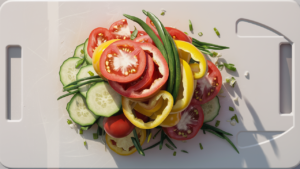In the bustling world of hospitality kitchens, precision and artistry merge seamlessly to create culinary masterpieces. One fundamental skill that sets apart the amateurs from the professionals is the mastery of vegetable cuts. Each cut serves a purpose, contributing not only to the visual appeal of the dish but also to its texture and flavor. Let’s delve into the importance of understanding vegetable cuts and explore 15 essential cuts along with their proper explanations.
1. Julienne Cut
The Julienne cut, also known as matchstick cut, involves slicing vegetables into thin, uniform strips. This cut adds visual elegance to dishes like salads and stir-fries, enhancing their texture and allowing for even cooking.

2. Brunoise Cut
In the Brunoise cut, vegetables are finely diced into tiny cubes, typically measuring 1 to 2 millimeters in size. This cut is ideal for adding subtle flavor and texture to sauces, soups, and garnishes.

3. Batonnet Cut
Similar to the Julienne cut, the Batonnet cut produces long, slender sticks of vegetables. These uniform pieces are perfect for dishes requiring a more substantial bite, such as vegetable medleys and crudité platters.

4. Paysanne Cut
The Paysanne cut involves slicing vegetables into thin, round shapes resembling coins. These delicate slices are often used to add visual appeal to soups, stews, and sautés, providing bursts of color and texture.

5. Chiffonade Cut
The Chiffonade cut involves stacking leafy greens, such as basil or spinach, rolling them tightly, and slicing them thinly into ribbons. These delicate ribbons are perfect for garnishing soups, salads, and pasta dishes, adding a touch of elegance and flavor.
6. Mirepoix Cut
The Mirepoix cut consists of diced onions, carrots, and celery sautéed together to form the flavor base of many dishes, including stocks, sauces, and braises.

7. Tourne Cut
The Tourne cut, also known as the “turned” or “football” cut, transforms root vegetables into small, seven-sided, oblong shapes. This intricate cut requires precision and skill, adding visual sophistication to dishes like stews and roasted vegetable medleys.
8. Concasse Cut
In the Concasse cut, tomatoes are peeled, seeded, and diced into small, uniform pieces. These diced tomatoes are often used in sauces, salsas, and bruschetta, imparting a burst of fresh flavor and vibrant color.
9. Macédoine Cut
The Macédoine cut involves dicing vegetables into small, uniform cubes, typically measuring 1 centimeter in size. These versatile cubes are perfect for adding texture and color to salads, soups, and vegetable medleys.

10. Oblique Cut
Also known as the roll cut or bias cut, the Oblique cut involves slicing vegetables at a 45-degree angle to create elongated, diamond-shaped pieces. This cut not only enhances the presentation of dishes but also promotes even cooking and caramelization.
11. Rondelle Cut
The Rondelle cut produces round slices of vegetables, perfect for layering in dishes like gratins, casseroles, and vegetable roasts. These uniform slices ensure even cooking and a visually appealing presentation.
12. Floret Cut
In the Floret cut, vegetables like broccoli and cauliflower are separated into small, bite-sized florets. These versatile pieces can be steamed, roasted, or stir-fried, adding texture and flavor to a variety of dishes.

13. Supreme Cut
The Supreme cut involves removing citrus segments from their membranes, resulting in juicy, bite-sized pieces free from pith and seeds. These citrus supremes are often used in salads, desserts, and garnishes, adding a burst of fresh flavor.
14. Tournée Cut
Similar to the Tourne cut, the Tournée cut transforms vegetables into small, barrel-shaped pieces with seven equal sides. This classic French cut adds elegance to dishes like soups, stews, and vegetable purées, showcasing the chef’s attention to detail.
15. Allumette Cut
The Allumette cut produces thin, matchstick-shaped pieces of vegetables, similar to the Julienne cut but slightly thicker. These slender strips are commonly used in dishes like stir-fries, soups, and salads, adding both visual appeal and textural contrast.
